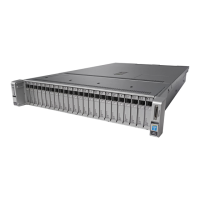3-55
Cisco UCS C240 M4 Server Installation and Service Guide
OL-32474-01
Chapter 3 Maintaining the Server
Installing or Replacing Server Components
Installing Multiple PCIe Cards and Resolving Limited Resources
When a large number of PCIe add-on cards are installed in the server, the system might run out of the
following resources required for PCIe devices:
• Option ROM memory space
• 16-bit I/O space
The topics in this section provide guidelines for resolving the issues related to these limited resources:
• Resolving Insufficient Memory Space to Execute Option ROMs, page 3-55
• Resolving Insufficient 16-Bit I/O Space, page 3-56
Resolving Insufficient Memory Space to Execute Option ROMs
The system has very limited memory to execute PCIe legacy option ROMs, so when a large number of
PCIe add-on cards are installed in the server, the system BIOS might not able to execute all of the option
ROMs. The system BIOS loads and executes the option ROMs in the order that the PCIe cards are
enumerated (slot 1, slot 2, slot 3, and so on).
If the system BIOS does not have sufficient memory space to load any PCIe option ROM, it skips loading
that option ROM, reports a system event log (SEL) event to the Cisco IMC controller and reports the
following error in the Error Manager page of the BIOS Setup utility:
ERROR CODE SEVERITY INSTANCE DESCRIPTION
146 Major N/A PCI out of resources error.
Major severity requires user
intervention but does not
prevent system boot.
To resolve this issue, disable the Option ROMs that are not needed for system booting. The BIOS Setup
Utility provides the setup options to enable or disable the Option ROMs at the PCIe slot level for the
PCIe expansion slots and at the port level for the onboard NICs. These options can be found in the BIOS
Setup Utility Advanced PCI Configuration page.
• Guidelines for RAID controller booting
If the server is configured to boot primarily from RAID storage, make sure that the option ROMs
for the slots where your RAID controllers installed are enabled in the BIOS, depending on your
RAID controller configuration.
If the RAID controller does not appear in the system boot order even with the option ROMs for those
slots are enabled, the RAID controller option ROM might not have sufficient memory space to
execute. In that case, disable other option ROMs that are not needed for the system configuration to
free up some memory space for the RAID controller option ROM.
• Guidelines for onboard NIC PXE booting
If the system is configured to primarily perform PXE boot from onboard NICs, make sure that the
option ROMs for the onboard NICs to be booted from are enabled in the BIOS Setup Utility. Disable
other option ROMs that are not needed to create sufficient memory space for the onboard NICs.

